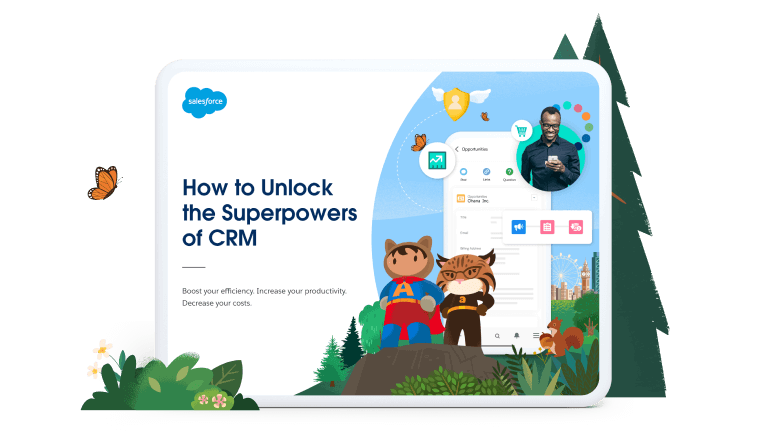What are customer needs? Answering that question may not always be easy – but it’s crucial for business success. After all, knowing what the customer wants is the starting point for creating winning products and services. Just as importantly, it’s the basis for forming long-lasting relationships.
The State of the Connected Customer report reveals that 62% of customers expect businesses to anticipate their needs, and 73% expect companies to understand their unique needs and expectations. If your business isn’t proactively working towards understanding its customer and addressing their concerns, it risks falling behind competitors that are.
Let’s take a look at how you can determine the needs of your customer – then go about satisfying them.
Find out what CRM can do for you in the Salesforce CRM Superpowers ebook
Get to grips with CRM and learn how it can help you cut costs and improve efficiency in your SME business.




What are customer needs?
Put simply, customer needs are the factors that influence the purchasing decisions of consumers and B2B buyers. By anticipating and meeting customer needs, brands can create offerings that better connect with the consumer and buyer, while increasing profitability and driving long-term loyalty.
Main categories of customer needs
There are many factors that might influence purchasing behaviour, from the simple and common to the complex and highly personal, but most fall into one of three types.
Practical. Customer needs are most often driven by practical considerations. These can include everything from price and availability to ease-of-use and functionality. If you’re offering a high-quality, low-cost product or service that’s easy to obtain or access, you’re catering towards practical customer needs. Customers driven by practical needs are likely to choose an offering that will simply help them perform a function or achieve a goal. This was once particularly true of B2B buyers, whose longer buying journey includes input from multiple stakeholders. But in a world where products and services often share similar price points, availability and functionality, B2B buyers are increasingly being influenced by emotional and social factors — whether they know it or not.
Emotional. What a customer wants can often be just as powerful a driver of purchases as what a customer needs. In other words, they may be driven by how an offering makes them feel. For example, they may choose a product that evokes pleasant memories from childhood. Or they may look for a product that makes them feel more confident or powerful. While a practical customer may choose a fuel-efficient compact car, an emotional one may splurge on a motorcycle. Consumers have always been influenced by emotional and social factors, but these factors are increasingly influencing B2B buyers as well. Harvard Business School professor Gerard Zaltman posits that 95% of cognitive decision-making happens subconsciously. This means that even buyers who think they’re being pragmatic are often responding to factors outside the rational. And this means that B2B organisations should focus on creating emotional bonds with buyers – not just winning over the procurement team.
Social. Some customers make purchases that are socially driven. For example, they may choose sustainable or ethical brands that reflect their lifestyle. Or they may opt for luxury products that are in-line with their social circle to keep up with the Joneses’. Socially driven needs are often considered to be the hardest to predict, but entire businesses have sprung up around tracking new trainer drops or tech releases. B2B buyers are also paying attention to socio-political factors in their purchasing decisions, as they need to justify partnerships to stakeholders. As such, they’re looking at their vendors’ CSR (corporate social responsibility), treatment of employees, environmental impact and community involvement in ways they never did before.
Decoding consumer needs: Unpacking product desires
Once you understand what your target customers need, you can start creating products that fulfil those needs and then marketing them effectively. However, those three categories of customer needs are very broad. It’s much easier to begin building products that fulfil those needs, if you can apply them to all the various aspects of product design and development.
In the shifting landscape of consumer needs, it’s crucial to understand the various factors that play a role in driving product selection and influencing purchasing decisions. So, let’s take a look at how nine aspects of product design relate to the three categories of customer needs.
Functionality: Bridging the gap between expectations and utility
When designing the functionality of a product, it’s vital to consider how it addresses the practical, emotional, and social needs of your target customers.
For practical needs, the product’s functionality needs to either resolve a specific problem or simplify a process for the user. Here you’re looking at your product’s core utility and what you’re going to promise your customers about what your product can do for them. When designing the functionality of a product to meet the practical needs of your audience, it’s a good idea to focus on usability, ensuring it’s intuitive.
Addressing emotional needs involves creating a user experience that consumers will enjoy. It doesn’t matter how well your product meets your customer’s practical needs, if they don’t enjoy using it they simply won’t use it and therefore they won’t recommend it to their friends. So, when designing your product’s functionality, it’s also a good idea to aim to evoke positive emotions like comfort, delight, or a sense of achievement.
Social needs are fulfilled when a product either helps people interact with others or elevates their social status. Some of the best products do both. When designing your product’s functionality to meet your customers’ social needs, think about how it could enable sharing or collaboration, helping users feel connected. Or, if that’s not possible, try to incorporate something that will help your product become a status symbol once it becomes popular. Anything you can do to help your users feel a sense of pride or belonging within their social circle when using your product is going to help make your product popular.
So, when it comes to designing the functionality of your product, you’ll get the best results if you can ensure it:
- Solves a problem or simplifies a process
- Is easy and intuitive to use
- Is comfortable to wear or use
- Delights your audience
- Helps users collaborate, share, or connect with friends, family, work colleagues etc.
- Gives people a sense of pride to own and use or helps them feel like they belong within their social circle
The price conundrum: Balancing affordability and value
In the same way that product functionality needs to meet the practical, emotional, and social needs of the intended users, so too does product pricing need to meet all three categories of customer needs.
When it comes to practical needs, the price must align with the perceived functionality and utility of the product. Customers need to feel they’re getting their money’s worth, and the cost of the product should correspond with its ability to solve a problem or enhance a process. Price also plays a practical role in the customer’s budgeting, so providing a range of options or payment plans can be beneficial.
Addressing emotional needs involves the psychological aspects of pricing. The price can evoke emotions of satisfaction or discontent, based on perceived fairness and value for money. If a product is priced too high, it may deter potential customers; if too low, it might create doubt about its quality. Therefore, a pricing strategy should strive to create a positive emotional response, where the customer feels they’re making a worthwhile investment.
Social needs pertain to the status symbol a product’s price can represent. For some consumers, purchasing premium or expensive items is a way to express their identity and status. Conversely, other consumers may derive pride from finding the best deals and saving money. It’s therefore essential you understand these dynamics within your target audience, and develop pricing strategies that respect and cater to these social needs.
Therefore, a well-crafted pricing strategy should aim to:
- Align with the product’s utility and the customer’s budget constraints
- Evoke positive emotions by providing perceived value for money
- Cater to the social needs of the target audience, whether they be prestige-seeking or bargain-loving.
Convenience: The silent influencer in consumer preferences
Designing a product for convenience is yet another balancing act that must address the practical, emotional, and social needs of customers.
For practical needs, ensure your product simplifies tasks and is easy to use. A product that seamlessly fits into the customer’s daily routine and requires minimal effort to operate ticks the boxes for practical convenience.
Emotionally, a convenient product brings peace of mind and reduces stress, making the customer’s interaction with the product enjoyable. The more effortless the experience, the more positive the emotional response.
Social needs are met when the product aligns with the customer’s lifestyle and collaborating with it, or sharing it, is effortless.
In short, when optimising your product for convenience:
- Make your product user-friendly and time-efficient
- Aim for a stress-free, enjoyable customer experience
- Ensure collaborating with or sharing you product is easy
Design matters: The aesthetic appeal in product selection
Sensing a pattern? Yep, you guessed it — design plays a significant role in addressing practical, emotional, and social customer needs too.
Practically, a well-designed product is easy to use and enhances the user’s efficiency. This involves thoughtful placement of elements, appropriate use of color and contrast for visibility, and a design that supports the product’s overall functionality.
Emotionally, the aesthetic of a product can evoke feelings of attraction, pleasure, and even joy. A visually appealing product not only enhances the user experience but also makes the product more desirable. It’s the emotional appeal of the design that often turns a one-time user into a loyal customer.
Socially, product design can influence how a product is perceived by others, often serving as a status symbol. A well-designed product can reflect good taste, sophistication, or a specific lifestyle, thus contributing to the user’s social identity.
A thoughtful product design should:
- Enhance usability and efficiency
- Create an emotional connection through visual appeal
- Cater to the social desires of the target audience
Reliability: Building trust through consistency
Reliability addresses the practical, emotional, and social needs of customers all in one go. From a practical perspective, a reliable product consistently performs as expected. Emotionally, reliability builds trust and reduces anxiety. Socially, the dependability of a product can enhance a user’s reputation.
Performance: Quality at the forefront
Similarly, performance addresses practical, emotional, and social customer needs all in one go. Practically, a product’s quality and operational excellence ensures it effectively delivers on its intended function. The key here is that the level of quality needs to match the customer’s expectation and your pricing strategy. E.g. There’s no point making a super endurable, disposable product as the cost would likely be too high for customers to stomach. Emotionally, a high-performing product can instill pride and satisfaction in the user. Socially, products known for their superior performance can elevate a user’s status among peers.
Efficiency: The quest for productivity
Product efficiency is fundamental in catering to the practical, emotional, and social needs of your customers.
Practically, an efficient product can simplify tasks, conserve resources, and save time for the user. It enhances the user’s productivity, proving its worth in their everyday routine. Here’s a great example of a product improving efficiency for a customer.
Emotionally, an efficient product can induce feelings of satisfaction and accomplishment. It can reduce stress by making tasks easier, and provide more time for enjoyment or relaxation, enhancing the user’s overall well-being.
Socially, an efficient product can serve as a status symbol, portraying the user as a conscious and responsible individual. In our increasingly eco-conscious society, products that promote efficiency are often viewed as desirable, elevating the user’s standing within their social circle.
An efficient product addressed the three categories of customer needs by:
- Simplifying tasks and saving time
- Inducing feelings of satisfaction and accomplishment
- Reflecting a responsible and eco-conscious image
Compatibility: The role of integration in consumer choice
The compatibility of your product with other products owned by your users is crucial in addressing practical, emotional, and social customer needs.
Practically, a compatible product that seamlessly integrates with existing systems or devices, can increase productivity for customers, reduce the learning curve for your product, and ensure your users don’t have to buy extra products to use what you’re offering.
Emotionally, a product that integrates easily can provide a sense of relief and satisfaction. It simplifies the user’s life, reducing potential stress and frustration that may come from incompatible devices or systems.
Socially, compatibility can enhance the user’s status in their circle. Having a product that works harmoniously within an ecosystem of devices demonstrates a user’s savvy tech awareness and can be a source of pride.
When designing your products, it’s a great idea to consider how compatibility could provide a better experience for your users. Compatible products:
- Seamlessly integrate with existing systems or devices
- Provide emotional satisfaction by simplifying the user’s life
- Enhance the user’s social standing by demonstrating tech-savviness
The experience quotient: More than just interaction
Customer experience is the culmination of every other part of the product design process. Products deliver a good customer experience if they:
- Are intuitive, or at least have great instructions that make them easy to use
- Perform well and reliably
- Easily integrate with existing workflows and products
- Generate positive feelings such as joy, satisfaction, or excitement
- Make it easy for users to share their experience or feel like they belong when using the product
- Make users look good within their society
If you’re looking for ways to improve your customer experience, here are six ways to improve CX with data and measurement.
Navigating the terrain of service needs
Just as key facets of product design can fulfil all categories of customer needs, so too can the critical elements of service design meet all three categories of client needs. When designing new service for your clients, you’ll get the best results if you consider each aspect of the service from the following angles.
Empathy: The key to service satisfaction
Empathy is one of the most important customer service skills you can employ and building empathy into your services themselves also plays a vital role in meeting the practical, emotional, and social needs of your clients.
Practically, empathetic customer service provides solutions that truly fit the customer’s needs, thereby enhancing the overall value of the service.
Emotionally, empathy can evoke feelings of being understood and valued, fostering a deeper connection between the customer and the service provider.
Socially, customers who experience empathetic service are more likely to share their positive experiences, enhancing their status within their circles.
When developing your services, see if you can incorporate empathy into your design process by:
- Really understanding what your clients need, so you can design the best solution
- Ensuring your clients feel understood and valued
- Making is socially desirable for your clients to share their experience with you
Fairness: The foundation of trust
Fairness is also crucial in addressing the practical, emotional, and social needs of your clients.
Practically, fair service policies ensure everyone is treated equally and without bias, enhancing the overall reliability of the service.
Emotionally, fairness can instill feelings of trust and respect, strengthening the customer-provider relationship. A good example of an unfair practice that really annoys clients is when service providers offer discounts for new clients without rewarding loyal clients.
Fairness is perhaps most relevant, however, to the social needs of your target audience. If they’re driven by the need to be ethical, they’ll want to know your services are fair to all clients, without any kind of social bias. Alternatively, for some target audiences, social responsibility might be a bigger driver, and they may be more likely to buy from a service provider that provides discounts for not-for-profits or contributes to worthy causes.
Fairness means different things to different audiences, so when designing your services, you might consider:
- Ensuring equal and unbiased treatment of all clients
- Balancing attraction tactics with loyalty strategies
- Giving back to underserved communities or those in need
Transparency: The service game-changer
There are practical, emotional, and social aspects to transparency too.
Practically, transparent service operations enable customers to make informed decisions, increasing the service’s utility.
Emotionally, transparency can induce feelings of trust and loyalty, making the service more desirable.
Socially, transparency enhances a customer’s social standing as they can confidently vouch for the service to their circle. It also gives clients the confidence that a service provider is honest and ethical.
Many businesses get nervous about sharing their inner workings, worrying that competitors might copy them. However, there are several benefits to transparency:
- Clients like that they can make informed decisions
- It fosters trust and loyalty
- Clients are more likely to recommend transparent services from honest, ethical businesses
Control: A new era in customisation
Control is another aspect of service design that can enable you to address the practical, emotional, and social needs of your clients.
Practically, giving customers control by allowing them to customise their services enables them to choose a service that exactly meets their needs, enhancing their overall experience and satisfaction.
Emotionally, control can incite feelings of empowerment and freedom, making the service more enjoyable.
Socially, having control enables customers to tailor the service to their social context, making it more shareable and recommendable.
The benefits of giving control to your clients can be highly rewarding:
- Enhanced customer experience and satisfaction, which leads to increased conversions along with greater loyalty and advocacy
- Feelings of empowerment and freedom, which also leads to increased loyalty
Options: Choice is power
Options are an important way you can give your clients more control over their services and therefore options are a key way of meeting the practical, emotional, and social needs of your clients.
Information: The fuel of knowledgeable decisions
You might think giving your prospective clients information only fulfils their practical needs, but, with the right strategy, it fulfils emotional and social needs too.
Providing sufficient information empowers customers to make informed decisions, which is critical if they’re to choose a service that meets their practical needs by solving a problem for them. This includes the decision to buy as well as making informed choices about any options you offer.
Emotionally, information can evoke feelings of confidence and trust, making the service more appealing.
Socially, informed customers are more likely to share their knowledge, enhancing their social interactions and status, and effectively giving you free advertising and even free customer support. Apple’s support community is probably one of the most well known examples of this.
In short, providing information can:
- Foster confidence and trust
- Ensure your clients get what they need from your service, reducing churn and increasing referrals
- Enable you to create a community around your service and reduce your advertising and customer support costs
Accessibility: Anywhere, anytime service
Accessibility is perhaps the element of service design where it’s most obvious how to meet the practical, emotional, and social needs of clients.
An accessible service gives clients what they need, when they need it. That includes allowing clients with disabilities to benefit from your services. Accessibility therefore addresses the practical needs of clients in several ways.
A client who can’t access the services they need when travelling, will get really frustrated. Whereas a client who can start a project on their desktop in the office, continue it in the car on the way home by dictating to their mobile, and then continue on their home computer at the end of their journey, is likely to be pretty chuffed. These examples illustrate just how much of an impact accessibility has on whether a service meets the emotional needs of clients.
A client who wants to share their service with friends when traveling, or use it to collaborate with their blind assistant on the other side of the world, is far more likely to choose a service provider that enables them to easily share their fully accessible service with others.
To summarise, an accessible service:
- Can be used in any location at any time
- Has online and offline capabilities and can be used on any device (if it’s a digital service)
- Can be used by people with disabilities
- Enables sharing
Eight ways for identifying the needs of your customers
When it comes to addressing customer needs, a one-size-fits-all approach won’t work. For instance, you’ll want to tailor your messaging to prioritise the distinct concerns of different audiences.
But how can you gain key insights into your customers, so that you can not only meet their needs, but exceed their expectations? Here are 8 strategies for getting started.
- Follow your data. We’re living in the age of the digital imperative. You likely already have a wealth of information about your customers at your disposal, especially if you’re centralising your data in a CRM. Take a deep dive into your business’s data and see what’s connecting with customers, what can be improved, and what new opportunities can be identified from it.
- Talk to your customers. The best way to know what your customers want is to simply ask them. Deploying post-purchase surveys will help you evaluate your customer experience. You can also reach out to loyal customers for opinions on products and services. They may have some great ideas for improvements and new offerings.
- Raise your social media game. Try to engage with your customers in the places where they spend their most time. For many, that’s social media. Listen in on what people are saying about your business. Are you seeing recurring concerns? Can you use this information to drive improvements? Are you using your brand’s social media presence to showcase your voice and build more personal relationships?
- Gather feedback from your teams. Your sales and service teams speak to your customers frequently. Gather your reps and discuss what they’ve been hearing from customers. Do your teams have suggestions for new products or services? Do they have ideas for how you can improve the customer experience?
- Form a focus group. Forming a focus group isn’t for every business. After all, it can be costly. Moreover, these groups will not have the same in-depth knowledge of your offerings as your customer base will. But if you’re looking to move into new markets, a focus group can put you on the right path.
- See what people are searching for. One of the most cost-effective ways to see what customers need is to see what they’re searching for. You can use tools like Google Keyword Planner to gain insights into customer behaviour. You can see how many times phrases and keywords have been searched each month, so you can see what’s trending up. Or you could use Google Trends to see more specific data, with searches being further segmented.
- Learn from your competitors. Your competitors are helping to define your marketplace, so it’s important to keep up with any new products or services they’re offering. Look for ways you can use this market intelligence to improve your offerings or create new ones. You’ll also want to pay attention to their messaging. How are they positioning themselves? After all, they’re trying to reach the same customers you are.
- Use Artificial Intelligence. Artificial intelligence is one of the most customer-centric technologies that SMES can use. Not only can AI tools analyse data to identify unique needs and preferences; they can help SMEs create tailored customer journeys. AI can also increase efficiency, improve service and create more customer-centric marketing campaigns.
You understand the needs of your customer – what’s next?
Now that you know the needs of your customers, you can build a blueprint for meeting them.
Some of the steps towards building a customer-centric strategy include:
- Get regular feedback from your customers. Talking to your customers isn’t a one-time thing – it should be done regularly. Establish a feedback loop where you can constantly evaluate the products and services you’re offering, and the market’s response to them. This regular monitoring of consumer needs will help you respond quickly to market shifts and emerging customer concerns.
- Perfect your brand’s messaging. You’ll want to create different messaging for different audience segments, considering their specific needs and the channels through which they shop. Make sure that your marketing is aligned with customer needs and that your communications highlight the most relevant benefits of your products and services.
- Brainstorm new products and services. Knowing what your customers value and prioritise when making a purchase will help you create innovative offerings that not only address their needs, but stand out from the crowd. Look at the results from your focus research. Is there a gap between what customers need and what’s available?
- Create the need. Some businesses have an ‘if you build it, they will come’ approach. Instead of researching and responding to the existing needs of their customers, they create a new need in their customers. For example, it’s unlikely that socially conscious Millennials are wishing there was a credit card made just for them, but if you offer a card that donates to charities, provides rewards based on purchases from sustainable businesses, and sponsors community building, you may create that customer need.
- Level up your loyalty programme. Look at your business’s loyalty programme. Is it centred around the needs of your customers? Is it offering value at the right places? Loyalty programmes are a powerful tool for building relationships, so ensure that your programme is working as hard as it could be.
- Re-evaluate your customer service KPIs. Quick and convenient should always be the priority when it comes to customer service. But once that frictionless service is in place, can you add further value to the customer experience? Look at your service KPIs (Key Performance Indicators) and see if they can be supplemented to not only measure successful resolutions, but how well you’re meeting the ongoing needs of your customers. In other words, turn your service into a relationship-building machine.
Ready to follow customer needs to exciting new places?
By following the needs of your customer, you can ensure that you’re always putting them first. And by designing your business around offering solutions, you’ll be well on your way to winning trust and increasing customer retention.
See how customer-centricity can help build relationships and how digital tools can help







![[Illustration] An AI agent helps a customer service rep solve cases.](https://www.salesforce.com/ap/blog/wp-content/uploads/sites/8/2025/06/Agentforce-for-Service-Relaunch-1500x844-1.jpg?w=150&h=150&crop=1&quality=75)















![[Illustration] An AI agent provides B2B customer service](https://www.salesforce.com/ap/blog/wp-content/uploads/sites/8/2024/12/B2B-AI-Agents-1680x1120-1.jpg?w=150&h=150&crop=1&quality=75)


